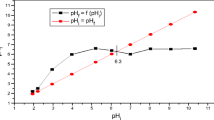Abstract
Palygorskite and sepiolite show a high sorption capacity for organic molecules. Adsorption of 2 organic cations, methylene blue (MB) and crystal violet (CV), by palygorskite and sepiolite were examined. The maximum sorption of MB and CV far exceeded the cation exchange capacity (CEC) of these minerals. This shows that, besides the contribution of free negative sorption sites (P-), the sites satisfied with sorption of single cations (PXi0) and neutral sorption sites (N) on clay surfaces may contribute to the sorption of organic cations. The number of neutral sites was determined by examining the sorption of 2 neutral organic molecules, triton-X 100 (TX100) and 15 crown ether 5 (15C5), and by application of the Langmuir isotherm.
To determine the contribution of different sites, an adsorption model that applies the Gouy-Chapman equation and takes into account the formation of different clay-organic complexes in a closed system was employed. Application of this model to sorption data provided the calculation of binding coefficients for neutral sites, as well as the surface potential of the minerals at different sorbate concentrations.
At sorption maxima, for both palygorskite and sepiolite, the contribution of neutral sites for sorption of organic cations was the highest, followed by the PXi0 sites in case of CV sorption, while in sorption of MB the contribution of P- sites was the second highest. The Fourier transform infrared (FTIR) patterns of clay-organic cation complexes compared with pure clays confirm that the sorption of organic cations is by silanol groups located at the edge of fibrous crystals, which account for neutral sorption sites.
Similar content being viewed by others
References
Ahlrichs JL, Serna C, Serratosa JM. 1975. Structural hydrox-yls in sepiolite. Clays Clay Miner 23:119–124.
Aznar JA, Casai B, Ruiz-Hitzky E, Lopez-Arbeloa I, Lopez-Arbeloa F, Santaren J, Alvarez A. 1992. Adsorption of methylene blue on sepiolite gels: Spectroscopic and Theological studies. Clay Miner 27:101–108.
Banerjee K, Dureja P. 1995. Photo stabilization of quinalphos by crystal violet on the surface of kaolinite and palygor-skite. Pesticide Sci 43:333–337.
Bergmann K, O’Konski CT. 1963. A spectroscopic study of methylene blue monomer, dimer, and complexes with montmorillonite. J Phys Chem 67:2169–2177.
Casal Piga B, Ruiz-Hitzky E. 1977. Reaction of epoxides on mineral surfaces. Organic derivatives of sepiolite. Proc 3rd Eur Clay Conf.; Oslo. p 35–37.
Cenens J, Shoonheydt RA. 1988. Visible spectroscopy of methylene blue on hectorite, laponite B and barasym in aqueous suspension. Clays Clay Miner 36:214–224.
Delahay P. 1965. Double layer and electrode kinetics. New York: Interscience Publ. 321 p.
Galan E. 1996. Properties and applications of palygorskite-sepiolite clays. Clay Miner 31:443–453.
Gerstl Z, Mingelgrin U. 1979. A note on the adsorption of organic molecules on clays. Clays Clay Miner 27:285–290.
Gerstl Z, Yaron B. 1981. Attapulgite pesticide interactions. Residue Rev 78:69–99.
Hang PT, Brindley GW. 1970. Methylene blue absorption by clay minerals. Determination of surface areas and CEC. Clays Clay Miner 18:203–212.
Hendershot WH, Lalande H, Duquette M. 1993. Ion exchange and exchangeable cations. In: Carter MR, editor. Soil sampling and methods of analysis. Boca Raton, Florida. Lewis Publ. p 167–176.
Hermosin MC, Cornejo J. 1986. Methylation of sepiolite and palygorskite with diazomethane. Clays Clay Miner 34:591–596.
Hermosin MC, Martin P, Cornejo J. 1993. Adsorption mechanisms of monobutyltin in clay minerals. Environ Sci Technol 27:2606–2611.
Kunze GW, Dixon JB. 1986. Pretreatment for mineralogical analysis. In: Klute A, editor. Methods of soil analysis, Part 1: Physical and mineralogical methods, 2nd ed. Madison, WI: SSSA. p 91–100.
Margulies L, Rozen H, Nir S. 1988. Model for competitive adsorption of organic cations on clays. Clays Clay Miner 36:270–276.
Nguyen TT, Janik LJ, Raupach M. 1990. Diffuse reflectance infrared furrier transform (DRIFT) spectroscopy in soil studies. Aust J Soil Research 29:49–67.
Nir S. I984. A model for cation adsorption in closed systems: Application to calcium binding to phospholipid vesicles. J Colloid Interface Sci 102:313–321.
Nir S. 1986. Specific and non specific cation adsorption to clays. Solution concentrations and surface potentials. Soil Sci Soc Am J 50:52–57.
Nir S, Bentz J, Wilschut J, Duzgunes N. 1983. Aggregation and fusion of phospholipid vesicles. Prog Surf Sci 13:1–124.
Nir S, Newton C, Papadhadjopoulos D. 1978. Binding of cations to phosphatidylserine vesicles. Bioelectrochem Bioenerg 5:116–133.
Nir S, Rytwo G, Yermiyahu U, Margulies L. 1994. A model for cation adsorption to clays and membranes. Colloid Polym Sci 272:619–632.
Ruiz-Hitzky E, Fripiat JJ. 1976. Organomineral derivatives obtained by reacting organochlorosilanes with the surface of silicates in organic solvents. Clays Clay Miner 25:25–30.
Rytwo G, Nir S, Margulies L. 1995. Interactions of monovalent organic cations with montmorillonite: adsorption studies and model calculations. Soil Sci Soc Am J 59:554–564.
Rytwo G, Serban C, Nir S, Margulies L. 1991. Use of methylene blue and crystal violet for determination of exchangeable cations in montmorillonite. Clays Clay Miner 39:551–555.
SAS Institute. 1985. SAS users guide: Statistics. Version 5 ed. Cary, NC: SAS Inst.
Serna CJ, Van Scoyoc GE, Ahlrichs JL. 1977. Hydroxyl groups and water in palygorskite. Am Mineral 62:784–792.
Shariatmadari H. 1998. Interactions of phosphates and selected organic molecules with palygorskite and sepiolite [Ph.D. thesis]. Dept. of Soil Science, Univ of Saskatchewan, Saskatoon, SK S7N 5A8 Canada. 195 p.
Spencer W, Sutter JR. 1979. Kinetic study of the monomer-dimer equilibrium of methylene blue in aqueous solution. J Phys Chem 83:1573–1576.
Van Olphen H. 1977. An introduction to clay colloid chemistry, 2nd ed. New York. J. Wiley. 318 p.
Wang MK, Wang SL, Wang WM. 1996. Rapid estimation of cation exchange capacities of soils and clays with methylene blue exchange. Soil Sci Soc Am J 60:138–141.
Author information
Authors and Affiliations
Rights and permissions
About this article
Cite this article
Shariatmadari, H., Mermut, A.R. & Benke, M.B. Sorption of Selected Cationic and Neutral Organic Molecules on Palygorskite and Sepiolite. Clays Clay Miner. 47, 44–53 (1999). https://doi.org/10.1346/CCMN.1999.0470105
Received:
Accepted:
Published:
Issue Date:
DOI: https://doi.org/10.1346/CCMN.1999.0470105




